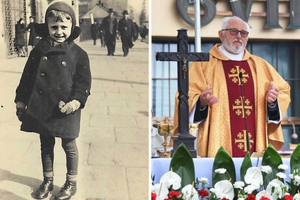Light Amid Darkness: Why the Films of Capra and Wilder Endure
Opposites and kindred spirits, directors offer stories showcasing the power of goodness, while acknowledging that evil exists.

Even those who may not be familiar with Hollywood director Frank Capra certainly know his work, as every Christmas season his now-classic film It’s a Wonderful Life is shown.
As beloved as this film is now, it was originally a flop and signaled the beginning of the decline of Capra’s filmography. Audiences in 1946 just didn’t warm up to this film, and it vanished from movie theater screens a few weeks after its initial release. Only when this forgotten film fell out of copyright did it begin building cultural momentum, as local TV stations across the country could show the film at no cost. The rest, as they say, is cinematic and television history.
Though the film is better than the critics and audiences believed it to be in 1946 and is worthy of its placement on the Vatican’s list of all-time great films, it has overshadowed the more complex and darker tones in Frank Capra’s work.
Capra’s life was as American as it gets: Born in Italy in 1897, he came to America as a child and fell in love with his new land. He assumed a classic immigrant persona: proud of his heritage, absorbed in the faith of his parents, while all the time forging a particular 20th-century American view of the world.
His creative high-water mark was the 1930s into the ’40s, and although just about every Capra movie I can think of has a traditional Hollywood happy ending, many contained a pessimistic realism at the outer edges.
Films like Meet John Doe and Mr. Smith Goes to Washington had signatory Capra light moments — what critics playfully referred to as “Capra-corn.” They also showed a darker side to humanity and one that makes Capra’s films, often too readily dismissed as light entertainment, worth revisiting for deeper themes.
Capra’s Catholicism permeates his films. John Doe and Mr. Smith certainly hold to the “Capra-corn” template and provide a viewer with an inspiring and positive resolution for the protagonist, which is a decidedly Catholic perspective, since what is our faith but the hope of the ultimate happy never-ending.
Yet both movies hold a darkness that is never resolved and lingers long after viewers see the words “The End” on the screen. In Mr. Smith, the naïve junior senator, played so perfectly by Jimmy Stewart, learns the hard way that a powerful political machine pulls the levers and controls the senior senator (Claude Rains) from his home state, a man Stewart’s character looks up to. When Stewart’s Jefferson Smith stands up to the political boss, the machine, with the senior senator’s acquiescence, sets out to destroy him.
Like all Capra movies, truth wins out, Stewart’s goodness triumphs, and even the senior senator finds a certain sense of salvation by finally confessing to all his ill deeds. But as all the cheering and the soaring film score bring the film to an end, Capra has left one thread untied: It is the same undone knot he leaves in many of his films. The political boss who was pulling all the strings has no Road to Damascus moment. He simply slinks back into the shadows. He will wait for another day and another character who may be more easily tempted and controlled to come along — and they always do. It was no wonder when Capra premiered this film in Washington for members of Congress that he received a chilly reception.
Evil survives in Capra’s other great film from the 1930s, John Doe, as well as in It’s a Wonderful Life. In the former, a media mogul (played by the terrific character actor of the day Edward Arnold, who also played the political boss in Mr. Smith), manipulates a story about an everyman who will commit suicide because he has lost faith in humanity. What starts as a media stunts soon devolves into something sinister: a political/social movement with fascist overtones. Gary Cooper, aka John Doe, speaks the truth to a crowd that had idolized the idea of a John Doe. The way the crowd turns on him is downright biblical and quite a dim view of the mentality of groupthink. Again, the evil mogul does not get justice. He may not win this time, thanks to the goodness of one man willing to speak the truth, but Capra makes sure viewers know that evil remains a constant.
Even in the warm-and-cozy town of Bedford Falls, a pall of darkness hovers. After George Bailey is rescued by the townspeople and everyone is singing Hark! The Herald Angels Sing, Mr. Potter, who is knowingly in possession of the missing Savings and Loan deposit, does not partake. His heart does not grow an inch. He has no Scrooge-like redemptive moment. Instead, he keeps the money for himself, and that’s the last we see of him.
What Capra was to the 1930s, Billy Wilder was to the 1940s and 1950s. Like Capra, he was an immigrant. He was born in 1906 in a part of the ancient regime of the Austrian-Hungarian Empire, which is now part of modern-day Poland. Wilder left Europe after Hitler came to power, given his justified fear as a Polish Jew. If there is a certain cynicism in his films, losing both parents in the Holocaust likely explains it.
Still, like Capra, Wilder the immigrant embraced a distinctive American voice in so many classic films. His protagonists may have been more nuanced than Capra’s idealistic ones, but Wilder had the same sense of a world that was basically broken and made up of sheep and wolves. Due to the fact Wilder was interested in bringing darkness into the light by making the main characters of many films tragically flawed, like in Double Indemnity and Sunset Boulevard, he attained many more accolades than Capra.
Wilder and Capra came from different worlds, as an Italian Catholic and a Polish Jew. And whereas Wilder rode the crest of the post-World War II shift in movies toward a grittier, and in some respects, uglier world, he, like Capra, could still mine for nuggets of goodness and decency in his films. Capra may have achieved the same effect with more sentimentality, but the belief in the power of goodness and the acknowledgement of a broken world where evil exists is the only way any of their films make sense.
Pope St. John Paul II, no stranger to theatrical arts, could have been talking about Wilder and Capra when he wrote, in his “Letter to Artists,” “Those who perceive in themselves this kind of divine spark which is the artistic vocation … feel at the same time the obligation not to waste this talent.”
As the 21st century comes out of its teens, the lines between good and evil in movies are often now blurred almost beyond demarcation. But viewers can always return to the art of Capra and Wilder. The thought about an artistic vocation Pope John Paul II wrote about works in both directions. Capra and Wilder met their obligation in creating this content. We can meet ours by appreciating it.
Robert Brennan writes from Los Angeles.
- Keywords:
- frank capra
- classic films
- good vs. evil
















